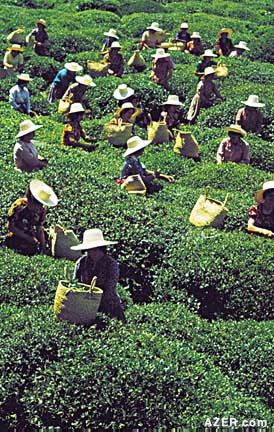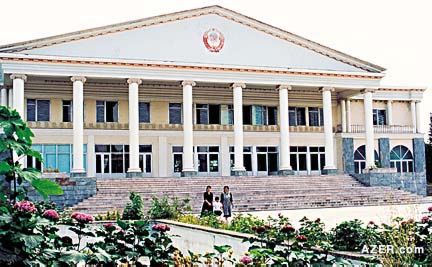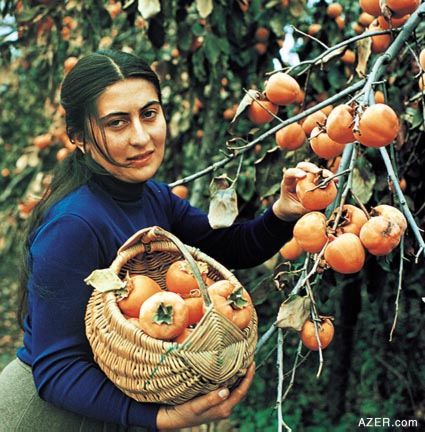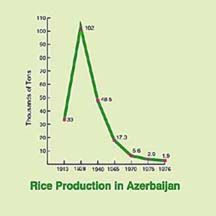|

Autumn 2000 (8.3)
Pages
28-31
Seeds of Change
Transition
in Azerbaijan's Agriculture
by
Arzu Aghayeva

Above:
Summer fruits
at the Taza Bazaar in Baku. Photo: Blair
Agriculture has long been a strong point for Azerbaijan. The
country's mix of rich farmland and a wide range of climatic zones
help support a wide variety of crops. But like other industries,
agriculture is still struggling to cope with the country's new
market economy. Under the Soviet system, Azerbaijan had a built-in
market for its vegetables, fruits, cotton, wool and raw silk,
since they were all sent to the All-Union Fund. In turn, the
Republic received products that it needed, like meat, dairy products
and grain.
Since independence, Azerbaijan has had to find new markets for
its agricultural products as well as new suppliers for the items
it has yet to produce itself. We talked to two experts from Azerbaijan's
Ministry of Agriculture about Soviet planning and today's complex
rebuilding process. Both agree that, despite major obstacles,
there is hope for the future of agriculture, Azerbaijan's second
- most important natural resource.
Private ownership of land ended when the Soviets took over Azerbaijan
in 1920. Farmland was then organized into state-owned agricultural
cooperatives, known as kolkhoz and sovkhoz. Soviet leaders mandated
which crops would be grown and where those crops would be sent
once they were harvested.
It soon became clear what tremendous potential Azerbaijan had
for agriculture, specifically for growing fruits and vegetables.
Lankaran in particular was perfect for planting cabbages, tomatoes,
eggplant and peppers. This region is located close to the southern
border near Iran. "Lankaran was so productive that they
called it 'The All-Union Garden,'" says Samad Garaisayev,
chief expert for Cattle Breeding Management at Azerbaijan's Ministry
of Agriculture.
  Vegetables also became
a specialty for kolkhozs and sovkhozs in Guba, Khachmaz and Masalli.
In all, Azerbaijan sent 500,000 to 600,000 tons of vegetables
each year to the All-Union Fund. Vegetables also became
a specialty for kolkhozs and sovkhozs in Guba, Khachmaz and Masalli.
In all, Azerbaijan sent 500,000 to 600,000 tons of vegetables
each year to the All-Union Fund.
"None of the other republics sent as many vegetables to
the Fund," says Sabir Valiyev, head of Cultivation Management
at the Ministry of Agriculture. "Early in April, our cabbages
were already being sold in Moscow and Leningrad, at a cheap price."
Left: Tea harvesting in the
Lankaran region, which is fairly close to the Iranian border.
Some of the vegetables grown in Azerbaijan were canned before
being sent on to other Soviet republics. These included pickled
cucumber, tomato, cabbage and eggplant as well as various kinds
of jams.
The cotton industry was also very important to Azerbaijan. In
the 1970s and 1980s, the Republic produced about 1 million tons
of cotton a year. However, since prices for cotton have gone
down in the world market, today's production has decreased significantly.
Less Grain, More
Wine
Grain production in Azerbaijan rose substantially during the
Soviet period, reaching more than 1 million tons a year in the
1970s and 80s. Part of this increase had to do with productivity-the
amount of grain harvested per acre more than tripled between
1913 and 1970.
Instead of developing the grain industry further, however, the
Soviets decided to concentrate on Azerbaijan's wine industry.
Grain growing was restricted. At the time, Azerbaijanis still
had enough grain for themselves, since deficits were supplemented
by the All-Union Fund.
One of the grains that was cut back was rice. Traditionally,
rice had been grown for a long time in Azerbaijan, mostly in
the southern regions of Masalli and Lankaran and also in Shaki,
in the northern region of Azerbaijan in the foothills of the
Caucasus mountains. The Soviet leaders reasoned that since plenty
of rice was being grown in other republics of the USSR, there
was no need to grow it in Azerbaijan.
In the 1970s, the Communist Party and the Cabinet of Ministers
issued special decrees for developing Azerbaijan's agriculture,
especially in terms of growing grapes for wine. Funds were allotted
for new railroads and water pipelines, and 70,000 to 80,000 hectares
of land were set aside for vineyards. The plan was for Azerbaijan
to produce 3 million tons of grapes per year by 1990. By 1982
Azerbaijan was already producing 2.1 million tons of grapes,
not so much by expanding its acreage, but by increasing productivity.
  Planned Economy Planned Economy
Left: Selling melons out of
the trunk of a car - a typical scene. In Lankaran. Photo: Blair
"During the Soviet period, we developed the branches of
agriculture that Moscow considered necessary: cotton-growing,
vine-growing, vegetable-growing," says Garaisayev. "But
too few of those crops were kept in Azerbaijan. For instance,
we sent cotton to Russia, which they used to process and produce
cloth. Of course, it enabled them to take all the profit."
"Moscow always wanted Azerbaijan to be dependent,"
he continues, "in cattle breeding as well as in other things.
Each year, Azerbaijan received an average of 1,200,000 tons of
milk and dairy products and about 35,000-40,000 tons of meat
and meat products from the All-Union Fund. We couldn't breed
our own cattle because we weren't allowed to grow the proper
feed for them. With the so-called 'planned economy' excuse, Moscow
hampered our cattle breeding."
As a result, Azerbaijanis consumed much less meat and dairy products
than people in other Soviet republics. For example, if an average
person in the USSR ate 65 kg of meat each year, for an Azerbaijani
it was closer to 37 kg.
Privatization
After Azerbaijan gained its independence, Parliament adopted
a new law facilitating the privatization of property in 1996.
Farmland was apportioned as personal property. Of all the CIS
countries, Azerbaijan has been the only one to use such a method.
In Kazakhstan, Uzbekistan and other former Republics, the land
is rented or leased for temporary use.
Tractors and other equipment were given to groups of farmers
based on a property - share arrangement; for example, one tractor
was designated for every 10 farmers. If a farmer doesn't have
access to a tractor, they can contract with those who do.As of
1996, nearly all farm animals were divided among the private
sector as well - 99.8% of the cattle and 98% of the sheep. The
remaining cattle and sheep are held by the government for breeding
purposes.

Above:
The Soviet
collective farm, known as a kolkhoz, found in the Ivanovka village
in the Ismayilli region in central Azerbaijan. This kolkhoz is
operated by Malakan Russians and during the Soviet period was
a model project because of its high production. Photo: Litvin
For each crop, it's up to the farmers to sell their own produce,
whether it's tomatoes, cucumbers, watermelon, berries or grapes.
The prices are set by the market demand, not by the government.
Farmers can sell their produce to other countries as well. Most
of it goes to the Russian cities of Volgograd and Astrakhan,
especially dates, tomatoes, cucumbers and watermelon. Hundreds
of tons of persimmons are grown each year in Shaki, Zagatala,
Ganja, Gazakh, Tovuz, Goychay and Aghdash.
Finding New Markets
Fruit ranks near the top of the list of Azerbaijani exports.
Azerbaijan produces 400,000 to 450,000 tons of fruit a year.
The region of Guba, for instance, is famous for its apples, especially
a sweet red variety called "Jir Haji". When other kinds
of apples were brought from abroad and grown in Azerbaijan, they
weren't as attractive or as resistant to disease. Another local
apple variety is called "Gizil Ahmad". This apple grows
mostly in Gabala, Oghuz and Ismayilli, in the mountainous places.
Processed fruit also has potential. "Last year we participated
in the Royal Agricultural Exhibition held each year in London,"
says Valiyev. "We took our jams and juice, such as fig jam,
berry jam and walnut jam. Representatives from 70 countries participated
in that exhibition. They were delighted with the taste of our
jams."
Because the Soviets had placed so much emphasis on Azerbaijan's
wine industry, it is still fairly viable. During the 1970s and
80s, Azerbaijani wines were sold in Moscow, Belarus, Estonia
and the Baltic. Table wines such as "Giz Galasi", "Yeddi
Gozal", "Gara Gila" and "Naznazi" are
made from the "Madrasa" pink grape, exclusive to Azerbaijan
and indigenous to Madrasa, a village in Shamakhi, a few hours
north of Baku.
"We participate in many international tasting committees
and international exhibitions," says Valiyev. "Lately
our wines have been receiving numerous gold medals. This year
our brandies won a gold medal at an International Tasting Convention
held in the U.S. We also participated in an international exhibition
held in Belgium. Five of our products won gold medals in an anonymous
taste competition among 156 countries: our champagnes and 'Golden'
vodka."
  Left: The produce section of Ramstore, the
first major supermarket to come to Baku in 1997. Photo: Blair Left: The produce section of Ramstore, the
first major supermarket to come to Baku in 1997. Photo: Blair
Self-Sufficiency
Crops that had been decreased during the Soviet period are gaining
ground once again. "We currently import rice from Iran,
Brazil and China," Valiyev says, "but now we are starting
to plant rice in Azerbaijan again. If in 1999 we planted rice
on 3,629 hectares, in 2000 we planted it on 4,437 hectares. We
hope that in the future Azerbaijan will be self-sufficient in
terms of its rice supply."
"After the collapse of the Soviet Union, we started growing
more grain, but it's still not enough," says Garaisayev.
"Azerbaijan currently produces 1.5 million tons of grain
per year-all for its own use - but it needs 2.5 million tons.
These days there is a tendency to replace vineyards with wheat
fields."
Another crop that is making a comeback is sugar beets. "Azerbaijan
used to grow sugar beets prior to the Soviet period," Valiyev
says.
"But when the Ukraine started cultivating the crop, there
was no longer any need to grow it, as they provided all of the
USSR's sugar. After we gained our independence, we started planting
sugar beets again in Nakhchivan, Beylagan, Sabirabad, Imishli
and Salyan. Today Azerbaijan plants about 50,000 to 60,000 tons
of sugar beets per year. But there are no sugar processing factories.
The beets have to be sent to Iran (Ardabil), across the border
from Bilasuvar (Azerbaijan). Iran processes the sugar beets and
returns the product to us. That makes the sugar too expensive
for our own consumers. We need to build our own factory in Azerbaijan."
One of the more profitable trends has been toward cattle farming.
"You can see that now we have a lot of meat and dairy products,"
says Garaisayev. "This comes from the private production
of our farmers. After privatization in 1996, cattle breeding
increased. Now people make money from this industry."
Valiyev notes that the quality of dairy products has also improved.
"Now our Azerbaijani companies are producing about 15 kinds
of dairy products: yogurt, cheese, cottage cheese and milk. You
can even see in the stores that our local dairy produce is outselling
foreign products."
New Challenges
Privatization of factories is still a major hurdle in the development
of agriculture in Azerbaijan. Production and processing are interdependent,
Valiyev says. "Producers need someone who will buy all of
their produce. They sell their produce in the market while it's
still fresh. But what can they do with the rest of it before
it spoils?"

Above: The persimmon is
a major crop in Azerbaijan. Photo: Huseinzade
Presently, only a few factories have been privatized and are
operating. Factories in Guba and Saatli produce small packages
of juice and various kinds of jam. Another factory in Lankaran
produces tomato paste. These three new factories export their
produce to various countries, such as Japan, Russia, Belgium
and Switzerland.
Tea processing factories also need to be privatized. Azerbaijan
used to produce 34,000 tons of tea a year in the 1970s; last
year, the harvest was only 1,900 tons. Part of the problem is
that there aren't any tea processing factories operating. Now
that the tea factories in Baku have been bought by a Turkish
company, farmers are starting to grow tea again. The Azerbaijani
tea is then mixed with other blends of tea from Turkey and India
before being sold.
Azerbaijan has suffered immensely because of the Nagorno-Karabakh
war. Today nearly 20 percent of our land is occupied by Armenians.
A great deal of it was valuable farmland. For instance, in the
Fuzuli region, we used to produce about 100,000 tons of grapes
per year; Zangilan had three grape processing factories with
3,000 hectares cultivated in vineyards. Aghdam was known for
its cotton, and Gubadli for its cattle. When Azerbaijanis fled
from their homes in these occupied territories, they had to leave
an estimated 145,000 cattle behind.
  For many growers and
producers, the problem is also a lack of cash-flow. "What
troubles us most these days is that we don't have a credit-union
system that allows farmers to borrow money," says Valiyev.
"Our Ministry wants to establish these credit unions in
every village. That way, when a landowner or a producer needs
funds, he can borrow from the credit union and purchase what
he needs. As soon as these credit unions are established, many
of our problems will be solved." For many growers and
producers, the problem is also a lack of cash-flow. "What
troubles us most these days is that we don't have a credit-union
system that allows farmers to borrow money," says Valiyev.
"Our Ministry wants to establish these credit unions in
every village. That way, when a landowner or a producer needs
funds, he can borrow from the credit union and purchase what
he needs. As soon as these credit unions are established, many
of our problems will be solved."
Left:
Rice production
in Azerbaijan fell dramatically during the Soviet period, as
rice was replaced by other crops.
If Azerbaijan can overcome these obstacles, prospects look good
for the future of agriculture in the country. "Our climate
and soil enable us to grow premium quality produce," says
Valiyev. "Now that privatization has begun, we'll soon witness
a rise in production."
"Now we are living in a transition period," says Garaisayev,
"but we have great plans for the future. Agriculture has
great potential in our country."
From Azerbaijan
International
(8.3) Autumn 2000.
© Azerbaijan International 2000. All rights reserved.
Back to Index
AI 8.3 (Autumn 2000)
AI Home
| Magazine Choice | Topics
| Store
| Contact
us
|